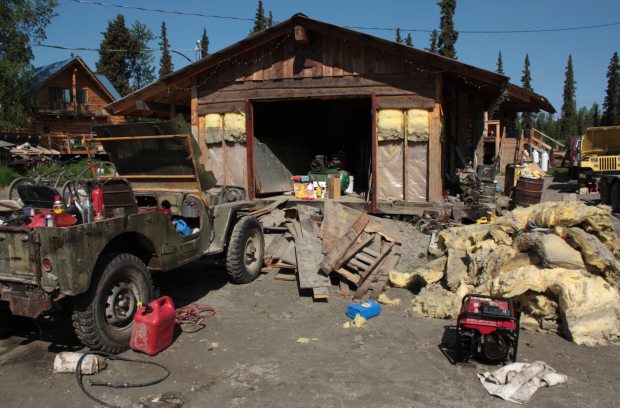Race against the clock: Rebuilding Galena, Alaska homes

Even though it’s mid-July with temperatures regularly soaring into the 70s, residents of the flood-decimated town of Galena are worried where they’ll live when the cold breath of winter returns in three months or less.
The Federal Emergency Management Agency (FEMA) is in the town of Galena on the banks of the Yukon River, trying to figure out how it will manage temporary housing for a “significant” number of people who will need shelter this winter. Their homes were largely destoyed by rising waters and huge chunks of ice that swept through town, pushing buildings off their foundations and leaving few buildings unscathed when the river broke up at the end of May.
These days, many residents are staying in the Galena Learning Academy, a boarding school that was formerly an Air Force base and escaped damage thanks to a dike constructed around the premises. But when students return in August, residents will be forced to leave.
Learning Academy residence life director Ken Essex told Alaska Dispatch in June that none of the boarding school’s 225 students have indicated that they will not return to Galena this autumn — though he suspects that will change as August approaches. He said enrollment will be capped at 200 students, allowing students who normally attend the local public school a chance to continue their education and have a safe place to eat and sleep during the school year, while the public school building is being rebuilt.
Uncertain relocation
As for the people currently taking shelter in the boarding school, “we don’t know” where they’ll relocate, Essex said.
FEMA is seeking bids from Alaska construction firms to rebuild single-family homes or provide prefabricated home-building kits for Galena and other communities hit by flooding. The application deadline is Wednesday.
The biggest barrier to rebuilding during the short summer? Getting construction supplies on site. There’s a “short window of opportunity to barge materials up there,” said FEMA spokesperson Tom Kempton. Barges bring supplies in from Nenana, which takes roughly a week.
FEMA is looking to rebuild at least 30 homes, and is still assessing some of properties. The federal agency has not begun rebuilding any residences yet, but residents are hard at work themselves.
Jenny Pelkola and her husband Dave hope to fix up their home to make it suitable for winter. They’ve ordered materials and are waiting for the supplies to arrive.
Hopefully they will be able to shelter at their home during the long Interior winter, but “I don’t know what’s going to happen.” Pelkola has applied for federal assistance from FEMA, and is waiting, for now.
One winter solution
Steve Erickson’s home was destroyed in the flood as rising waters reached his property in minutes. Now, “I’m waiting to basically get the OK to tear it down,” he said.
Winter is fast approaching, but at least he has a solution for this winter. Erickson found a place that had been a rental unit, and the owner, consumed with fixing his own home, didn’t have time to fix it up this summer. So Erickson offered a trade – he’s fixing up the rental unit in exchange for living there over the winter.
“That worked out good,” he said.
Erickson has already repaired the insulation and the area beneath the home, and he’s started putting up sheetrock and installing cabinets. “It’s moving along,” he said.
Next summer, he plans to rebuild his home, probably using a prefabricated kit from Spenard Builders’ Supply. “I marked the water line on the telephone pole” by his house, “so I know to build it above that,” he said.
Government efforts seem to be moving slowly, Erickson said, “but that’s government I guess. Most everyone here is not paying attention,” focusing instead on rebuilding their homes themselves.
FEMA coordinator Dolph Diemont said that plans to fly in around 150 volunteers are in the works. Among that group will be volunteers from Samaritan’s Purse, an agency that helped evacuate residents during the first few days of flooding, and the Mennonite Disaster Service, which assisted with the clean-up in Eagle after that upriver village was decimated during the breakup of 2009. The federal volunteer agency Americorps also has established a presence in Galena.
Two-hundred seventy-five people in Galena have registered with FEMA for disaster assistance, Diemont said. “We’ve just trying to leverage everything that we can to help them,” he said.
Recovery costs will be in the millions, he said.
Diemont praised Galena residents as the most “enthusiastic, positive, hardworking group” he has ever worked with. “Sometimes when you go to an impacted community, there’s no leadership. They’re just despondent. They don’t know what to do. Not here.”
Contact Laurel Andrews at laurel(at)alaskadispatch.com



